BUICK REGAL 1996 Owners Manual
Manufacturer: BUICK, Model Year: 1996, Model line: REGAL, Model: BUICK REGAL 1996Pages: 356, PDF Size: 17.97 MB
Page 251 of 356
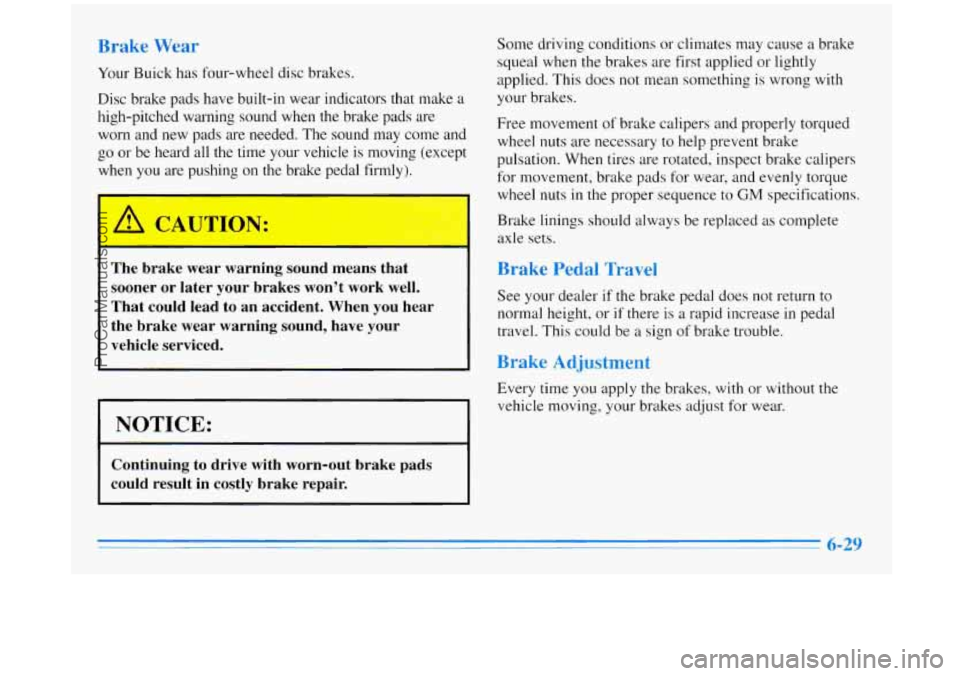
Brake Wear
Your Buick has four-wheel disc brakes.
Disc brake pads have built-in wear indicators that make
a
high-pitched warning sound when the brake pads are
worn and new pads are needed. The sound may come and
go or be heard all the time your vehicle is moving (except
when you are pushing on the brake pedal firmly).
A CAUTION:
I
The brake wear warning so Id means that
sooner or later your brakes won’t work well.
That could lead to an accident. When you hear the brake wear warning sound, have your
vehicle serviced.
I NOTICE:
Continuing to drive with worn-out brake pads
could result in costly brake repair.
Some driving conditions or climates may cause a brake
squeal when the brakes are first applied or lightly
applied. This does not mean something is wrong with
your brakes.
Free movement of brake calipers and properly torqued
wheel nuts are necessary to help prevent brake
pulsation. When tires are rotated, inspect brake calipers
for movement, brake pads for wear,
and evenly torque
wheel nuts
in the proper sequence to GM specifications.
Brake linings should always be replaced
as complete
axle sets.
Brake Pedal Travel
See your dealer if the brake pedal does not return to
normal height, or
if there is a rapid increase in pedal
travel. This could be
a sign of brake trouble.
Brake Adjustment
Every time you apply the brakes, with or without the
vehicle moving, your brakes adjust for wear.
ProCarManuals.com
Page 252 of 356
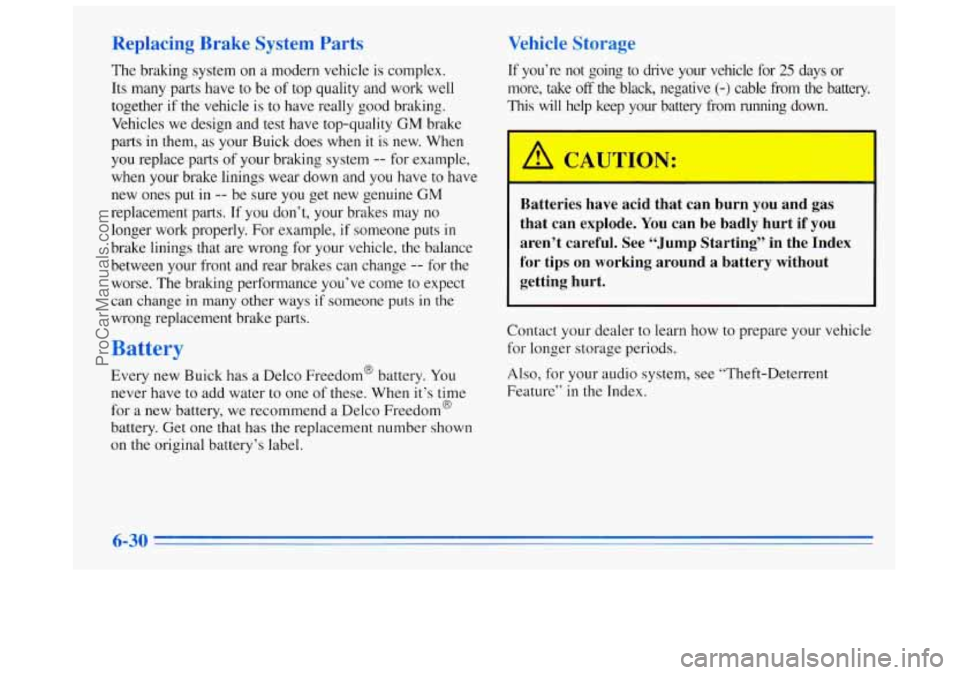
Replacing Brake System Parts
The braking system on a modern vehicle is complex.
Its many parts have
to be of top quality and work well
together if the vehicle is to have really good braking.
Vehicles we design and test have top-quality
GM brake
parts in them, as your Buick does when it
is new. When
you replace parts
of your braking system -- for example,
when your brake linings wear down and you have to have
new ones put in
-- be sure you get new genuine GM
replacement parts. If you don’t, your brakes may no
longer work properly. For example,
if someone puts in
brake linings that are wrong for your vehicle, the balance
between your front and rear brakes can change
-- for the
worse. The braking performance you’ve come to expect
can change in many other ways if someone puts in the
wrong replacement brake parts.
Battery
Every new Buick has a Delco Freedom@ battery. You
never have to add water to one of these. When it’s time
for a new battery,
we recommend a Delco Freedom@
battery. Get one that has the replacement number shown
on the original battery’s label.
Vehicle Storage
If you’re not going to drive your vehicle for 25 days or
more,
tLke off the black, negative (-) cable from the battery.
This will help keep your be++ary from running down.
J II’
Batteries have acid that can burn you and gas
that can explode.
You can be badly hurt if you
aren’t careful. See “Jump Starting’’ in the Index
for tips on working around a battery without getting hurt.
Contact your dealer to learn how to prepare your vehicle
for longer storage periods.
Also, for your audio system, see “Theft-Deterrent
Feature” in the Index.
6-30
ProCarManuals.com
Page 253 of 356
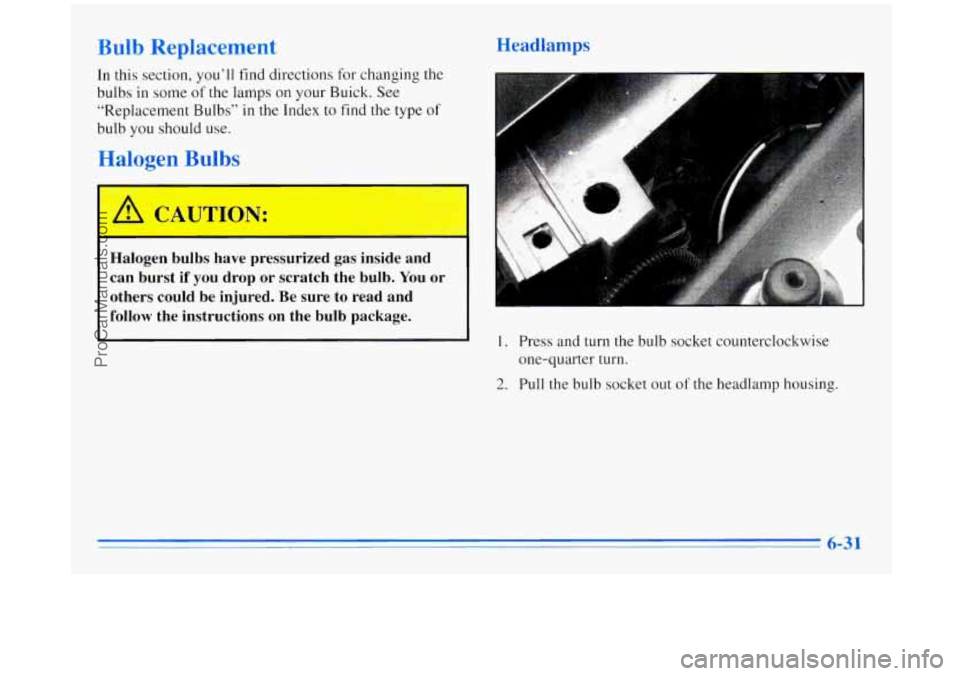
Bulb Replacement
In this section, you’ll find directions for changing the
“Replacement Bulbs”
in the Index to find the type of
bulb
you should use.
- bulbs in some of the lamps on your Buick. See
Halogen Bulbs
I
Halogen bulbs have pressurized gas inside and
can burst
if you drop or scratch the bulb. You or
others could be injured. Be sure to read and
follow the instructions on the bulb package.
I
Headlamps
I. Press and turn the bulb socket counterclockwise
one-quarter turn.
2. Pull the bulb socket out of the headlamp housing.
6-31
ProCarManuals.com
Page 254 of 356
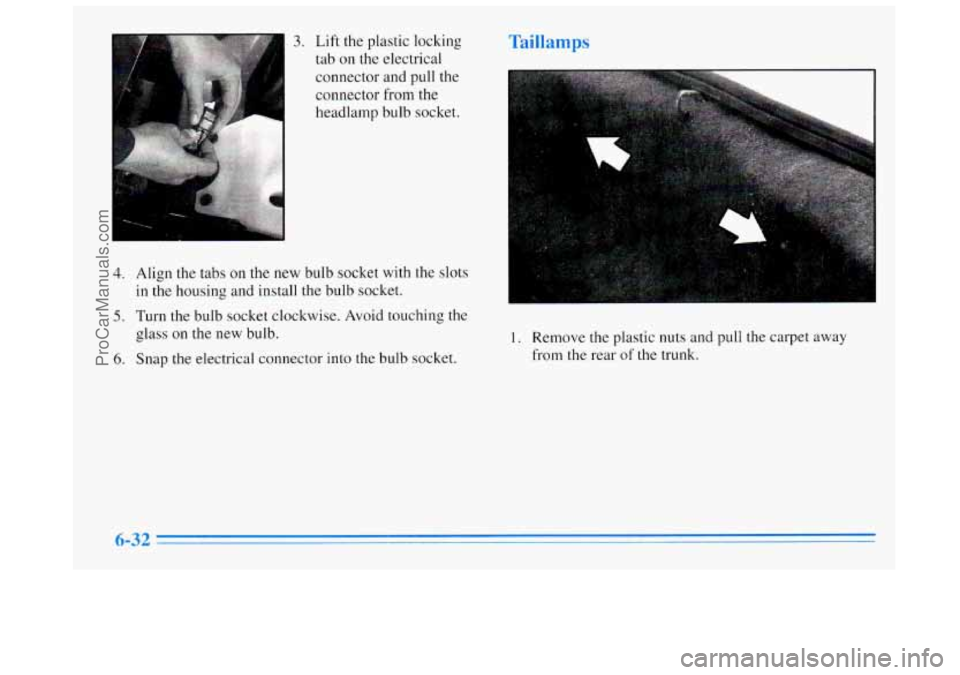
3. Lift the plastic locking
tab on the electrical
connector and pull the
connector from the
headlamp bulb socket.
4. Align the tabs on the new bulb socket with the slots
5. Turn the bulb socket clockwise. Avoid touching the
in the housing and install the bulb socket.
glass
on the new bulb.
6. Snap the electrical connector into the bulb socket.
1. Remove the plastic nuts and pull the carpet away
from the rear of the trunk.
ProCarManuals.com
Page 255 of 356
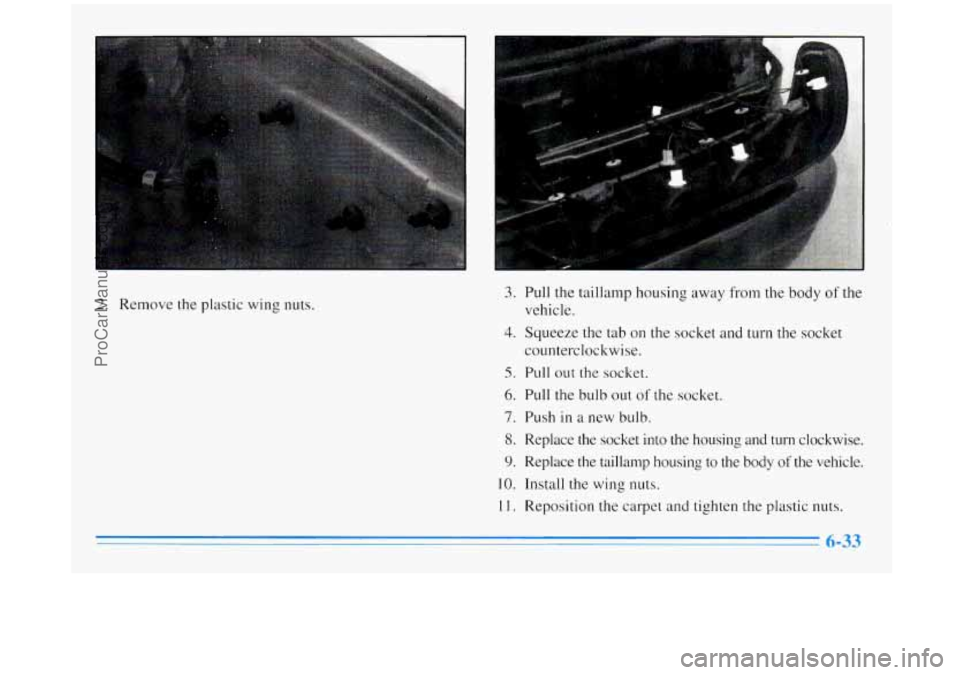
I
2. Remove the plastic wing nuts. Lwa
3. Pull
the taillamp housing a
vehicle.
.y from the body of the
4. Squeeze the tab on the socket and turn the socket
5. Pull out the socket.
6. Pull the bulb out of the socket.
7. Push in a new bulb.
8. Replace the socket into the housing and turn clockwise.
9. Replace the taillamp housing to the body of the vehicle.
counterclockwise.
10. Install the wing nuts.
11. Reposition
the carpet and tighten the plastic nuts.
6-33
ProCarManuals.com
Page 256 of 356
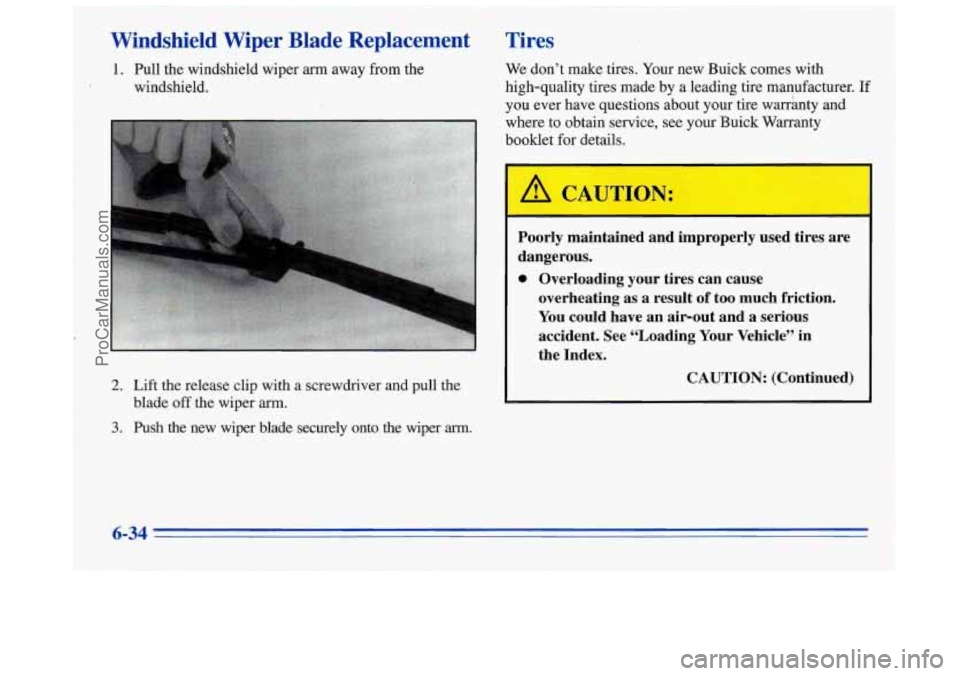
Windshield Wiper Blade Replacement
1. Pull the windshield wiper arm away from the
windshield.
Tires
We don’t make tires. Your new Buick comes with
high-quality tires made by a leading tire manufacturer. If
you ever have questions about your tire warranty and
where to obtain service, see your Buick Warranty
booklet
for details.
2. Lift the release clip with a screwdriver and pull the
3. Push the new wiper blade securely onto the wiper arm.
blade off the wiper arm.
Poorly maintained and improperly used tires are
dangerous.
0 Overloading your tires can cause
overheating
as a result of too much friction.
You could have an air-out and a serious
accident. See ‘(Loading Your Vehicle” in
the Index.
CAUTION: (Continued)
6-34
ProCarManuals.com
Page 257 of 356
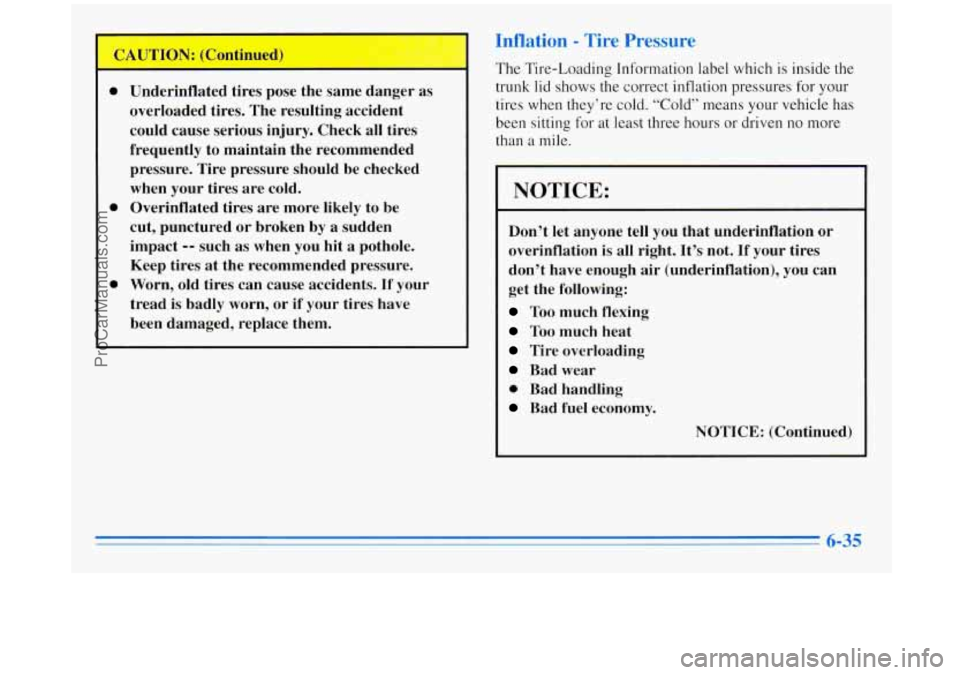
CAUTION: (Conunut
0
0
0
Underinflated tires pose the Sme danger as
overloaded tires. The resulting accident
could cause serious injury. Check all tires
frequently to maintain the recommended pressure. Tire pressure should be checked
when your tires are cold.
Overinflated tires are more likely to be
cut, punctured
or broken by a sudden
impact
-- such as when you hit a pothole.
Keep tires at the recommended pressure.
Worn, old tires can cause accidents.
If your
tread is badly worn, or if your tires have
been damaged, replace them.
Inflation - Tire Pressure
The Tire-Loading Information label which is inside the
trunk lid shows the correct inflation pressures for your
tires when they’re cold. “Cold” means your vehicle has
been sitting for at least three
hours or driven no more
than a mile.
NOTICE:
Don’t let anyone tell you that underinflation or
overinflation is all right. It’s not.
If your tires
don’t have enough air (underinflation), you can
get the following:
Too much flexing
Too much heat
Tire overloading
Bad wear
0 Bad handling
Bad fuel economy.
NOTICE: (Continued)
6-35
ProCarManuals.com
Page 258 of 356
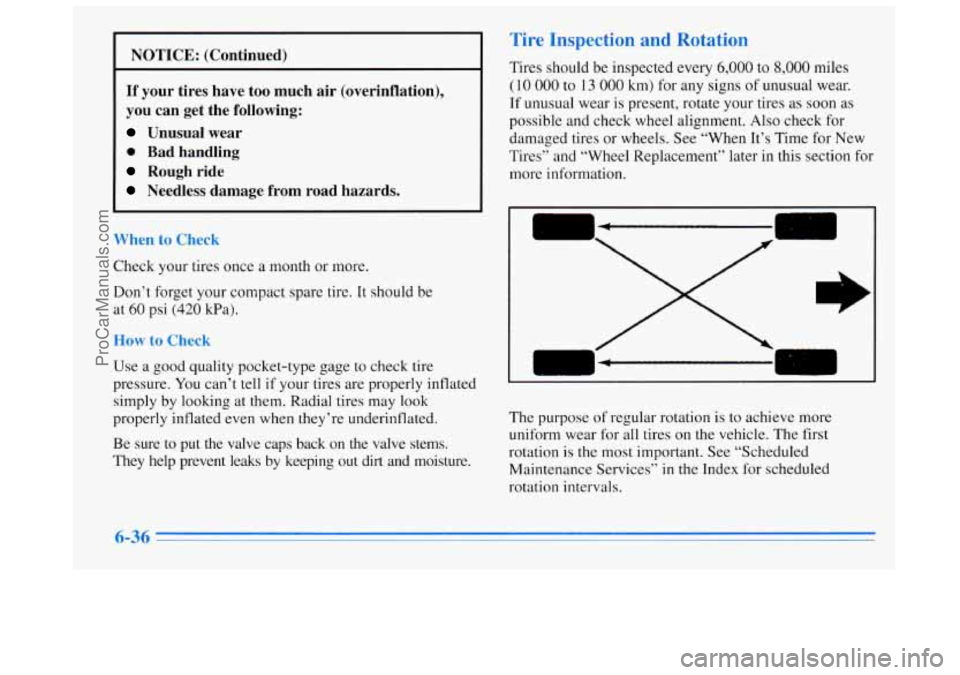
NOTICE: (Continued)
If your tires have too much air (overinflation),
you can get the following:
Unusual wear
0 Bad handling
Rough ride
Needless damage from road hazards.
When
to Check
Check your tires once a month or more.
Don’t forget your compact spare tire.
It should be
at
60 psi (420 kPa).
How to Check
Use a good quality pocket-type gage to check tire
pressure. You can’t tell if
your tires are properly inflated
simply by looking at them. Radial tires may look
properly inflated even when they’re underinflated.
Be sure
to put the valve caps back on the valve stems.
They help prevent leaks
by keeping out dirt and moisture.
Tire Inspection and Rotation
Tires should be inspected every 6,000 to 8,000 miles
(10
000 to 13 000 km) for any signs of unusual wear.
If unusual wear is present, rotate your tires
as soon as
possible and check wheel alignment. Also check for
damaged tires or wheels. See “When It’s Time for New
Tires” and “Wheel Replacement” later in this section for
more information.
The purpose of regular rotation is to achieve more
uniform wear for all tires on the vehicle.
The first
rotation is the most important. See “Scheduled
Maintenance Services”
in the Index for scheduled
rotation intervals.
6-36
ProCarManuals.com
Page 259 of 356
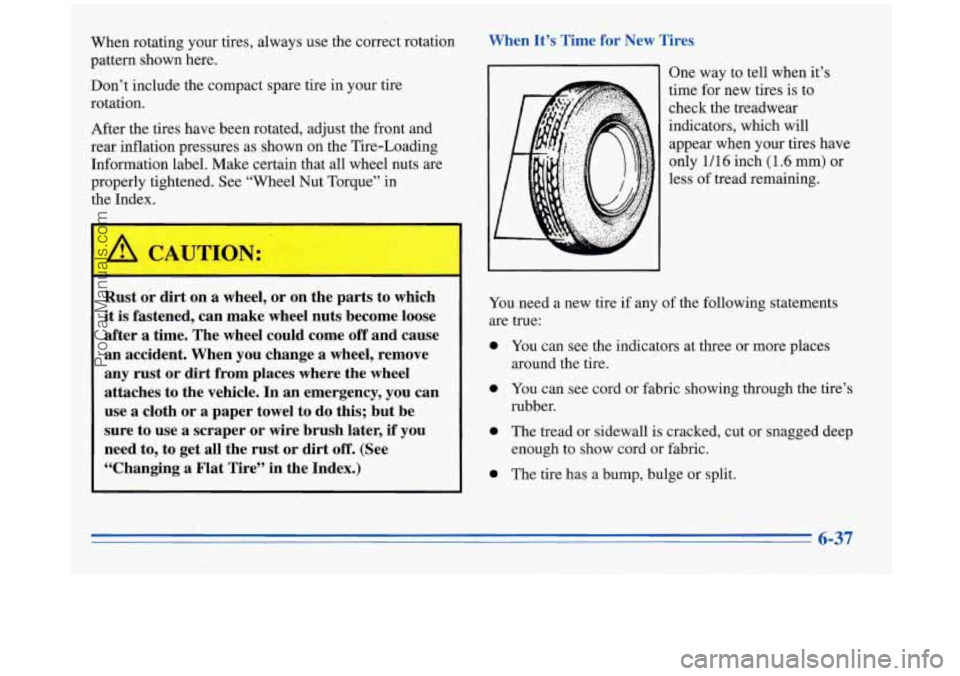
When rotating your tires, always use the correct rotation
pattern shown here.
Don’t include the compact spare tire in your tire
rotation.
After the tires have been rotated, adjust the front and
rear inflation pressures as shown on the Tire-Loading
Information label. Make certain that all wheel nuts are
properly tightened. See “Wheel Nut Torque” in
the Index.
Rust or dirt on a wheel, or on the parts to which
it is fastened, can make wheel nuts become loose
after a time. The, wheel could come
off and cause
an accident. When you change
a wheel, remove
any rust or
dirt from.places where the wheel
attaches to the vehicle. In an emergency, you can
use a cloth or a paper towel to
do this; but be
sure to use a scraper or wire brush later,
if you
need to, to get
all the rust or dirt off. (See
“Changing a Flat Tire” in the Index.) When
It’s Time for New Tires
One way to tell when it’s
time for new tires is to
check the treadwear
indicators, which will
appear when your tires have
only
1/16 inch (1.6 mm) or
less of tread remaining.
You, need a new tire if any of the following statements
are true:
0
0
0
0
You can see the indicators at three or more places
around the tire.
You can see cord or fabric showing through the tire’s
rubber.
The tread or sidewall
is cracked, cut or snagged deep
enough to show cord or fabric.
The tire has a bump, bulge or split.
6-37
ProCarManuals.com
Page 260 of 356
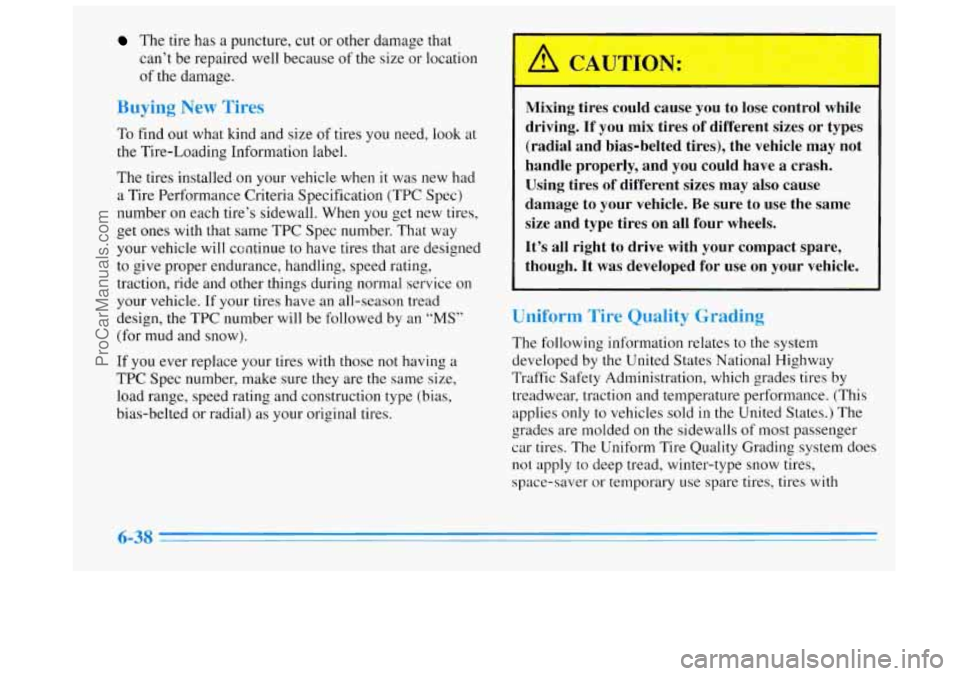
The tire has a puncture, cut or other damage that
can’t be repaired well because of the size or location
of the damage.
Buying New Tires
To find out what kind and size of tires you need, look at
the Tire-Loading Information label.
The tires installed on your vehicle when it was new had
a Tire Performance Criteria Specification (TPC Spec)
number on each tire’s sidewall. When you get
new tires,
get ones with that same TPC Spec number. That way
your vehicle will continue to have tires that are designed
to give proper endurance, handling, speed rating,
traction, ride and other things during normal service on
your vehicle.
If your tires have an all-season tread
design,
the TPC number will be followed by an “MS”
(for mud and snow).
If you ever replace your tires with those not having a
TPC Spec number, make sure they are the same size,
load range, speed rating and construction type (bias,
bias-belted or radial) as your original tires.
Mixing tires coula cause you to lose control while
driving. If you mix tires
of different sizes or types
(radial and bias-belted tires), the vehicle may not
handle properly, and you could have a crash.
Using tires
of different sizes may also cause
damage to your vehicle. Be sure to use the same
size and type tires
on all four wheels.
It’s all right to drive with your compact spare,
though. It was developed
for use on your vehicle.
Uniform Tire Quality Grading
The following information relates to the system
developed by the United States National Highway
Traffic Safety Administration, which grades tires by
treadwear, traction and temperature performance. (This
applies only to vehicles sold in the United States.) The
grades are molded on the sidewalls of most passenger
car tires. The Uniform Tire Quality Grading system does
not apply to deep tread, winter-type snow tires,
space-saver or temporary use spare tires, tires with
6-38
ProCarManuals.com